Tule Wind Project Deadline Exended
February 25, 2011 - Eastern San Diego County, California - The California Public Utilities Commission and U.S. Bureau of Land Management have extended the deadline for public comments on a draft environmental impact report and draft environmental impact statement (DEIR/DEIS) for several controversial and inter-related energy projects proposed for the Jacumba and Boulevard areas from February 16 to March 4, 2011.
Comments must be submitted by close of business on March 4, 2011. Written comments may be submitted via email to the CPUC at ecosub@dudek.com and to the BLM at catulewind@blm.gov. Faxed comments may be submitted to (800)371-8854 (press “2” to send a fax). Comments may also be mailed to Isan Fisher, CPUC/Greg Thomsen, BLM, c/o Dudek, 605 Third St., Encinitas, CA 92024.
http://www.eastcountymagazine.org/node/5535
Giant Transmission Corridor Plan Defeated in Court
February 1, 2011 - Today the Ninth Circuit Court by a 2-1 vote reversed and set aside the Department of Energy’s approval of the Southwest and Mid-Atlantic National Interest Electric Transmission Corridors (NIETCs) and the severely flawed Congestion Study on which they were based because the Department of Energy failed to conduct any environmental review under the National Environmental Policy Act of the adverse environmental impacts of the NIETC designations, and failed to consult adequately with the affected states as required by NEPA and the Energy Policy Act of 2005.
These proposed corridors would carve huge swaths through the affected states for future energy development, sweeping aside important environmental procedures and displacing state regulatory and siting controls in favor of a Fast-track federal approval process. The Federal Energy Regulatory Commission (FERC) is empowered to grant permits for transmission lines within the corridors if the state fails to permit the line within one year, and permit applicants are given the power to acquire rights-of-way for transmission lines through eminent domain.
Involved are 100 million acres in 10 states, including much of the Mojave Desert. The DOE report focused on the Mid-Atlantic states and a chunk of the Southwest that includes parts of Arizona and much of Southern California.
One proposed corridor would have included a wide swath across the California desert, through Death Valley and Joshua Tree national parks as well as the Mojave National Preserve, several military bases, Anza-Borrego Desert State Park and seven national forests.
This order was entered in the 9th Circuit Federal Court of Appeals:
In the Energy Policy Act of 2005, Congress specifically directed DOE to undertake a Congestion Study “in consultation with affected States.” 16 U.S.C. § 824p(a)(1). It further directed that in undertaking this study and in designating any national interest electric transmission corridors, DOE was to comply with NEPA. We determine that DOE failed to consult with the affected States prior to issuing its Congestion Study and that this failure was prejudicial to the States. Accordingly, the Congestion Study is vacated. We further find that DOE’s statement that its designation of NIETCs “does not significantly affect the quality of the human environment” is not supported by sufficient evidence to show that DOE has taken the requisite “hard look” at the environmental consequences.
The ruling will be a blow for utilities such as Los Angeles Department of Water and Power, Southern California Edison Co., and San Diego Gas & Electric Co., all of which have faced opposition to transmission lines that would extend hundreds of miles through numerous communities, cultural sites, and desert wildlife habitats.
Plaintiffs include Desert Protection Society, Center for Community Action and Environmental Justice, Backcountry Against Dumps, Desert Protective Council, Morongo Basin Conservation Association, Alliance for Responsible Energy Policy, Donna Charpied, Laurence Charpied, San Bernardino Valley Audubon Society, The Wilderness Society, California Wilderness Coalition, and National Resources Defense Council.
http://www.latimes.com/news/local/la-me-electric-corridors-20110202,0,835999.story?track=rss
http://calhounpowerline.com/2011/02/01/federal-9th-circuit-rules-nietc-corridors-illegal/
Join Ward Valley Remembrance
January 31, 2011 - The Ward Valley protest in the mid 1990s fought and won against a proposed low level nuclear waste repository in this beautiful desert valley held sacred by Tribes.

Senator Feinstein Crafts New California Desert Bill
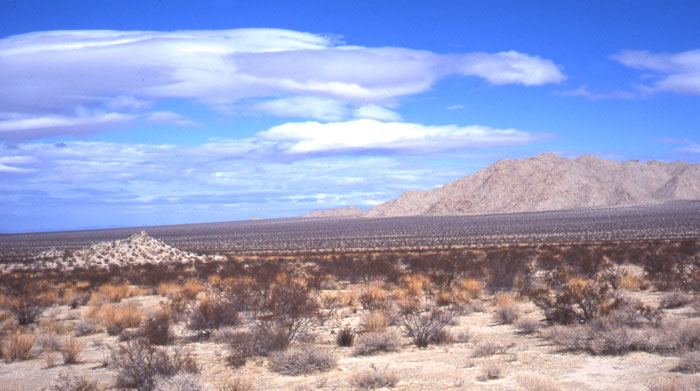
^An area along old Route 66 in the California Desert that would be made into a new National Monument.
January 25, 2011 - The Senate Natural Resources and Energy Committee would not mark up Senator Diane Feinstein's California Desert Protection Act bill last year, so she is trying to introduce a modified version, minus the solar energy provisions.
The “California Desert Protection Act of 2011” as drafted includes these highlights:
- Create the Mojave Trails National Monument, protecting 941,000 acres of federal land.
- Create the Sand to Snow National Monument, encompassing 134,000 acres of federal land.
- Add adjacent lands to Joshua Tree National Park, Death Valley National Park, and the Mojave National Preserve.
- Protect nearly 76 miles of four important waterways.
- Designate five new wilderness areas.
- Designate approximately 250,000 acres of BLM wilderness areas near Fort Irwin.
- Enhance recreational opportunities while ensuring training needs of the military have been met.
- Designate four existing off-highway vehicle areas in the California desert as permanent.
Feinstein said, "We know that we must do more to advance renewable energy, but we must also be careful where we decide to permit these projects. I strongly believe that we should not permit the development of land that was donated to the federal government or acquired with taxpayer funds for conservation.
"The Senate Energy and Natural Resources Committee prefers to move energy-related legislation separately from land conservation legislation. Therefore, I plan to work with senators from Western states on a bill to improve the renewable energy permitting process to allow quicker development of renewable energy projects on private and disturbed public land.”
But some environmentalists are alert to language in the bill that creates a new designation in Eastern Imperial County called a Special Management Area in which ORV use would be allowed in areas of important Native American cultural resources without a management plan. The bill still makes permanent four existing Bureau of Land Management ORV recreation areas with no new management plans required.
A Feinstein office staffer told us that they are stripping the entire Title II section of the bill that had all the renewable energy provisions. She has not by any means given up pushing legislation improving the way Department of Interior reviews and permits solar projects in the California Desert, but this will simply have to be addressed in a separate bill at the request of Chairman Jeff Bingaman (D-NM). What exactly would be in that bill is still being worked out, but Sebator Feinstein's office said she is certainly sensitive to the concerns raised by the environmental community over the past year.
http://www.pe.com/localnews/stories/PE_News_Local_D_desert26.1fd0fba.html
http://www.desertdispatch.com/news/renewable-10174-energy-desert.html
Tule Wind Draft EIS Out
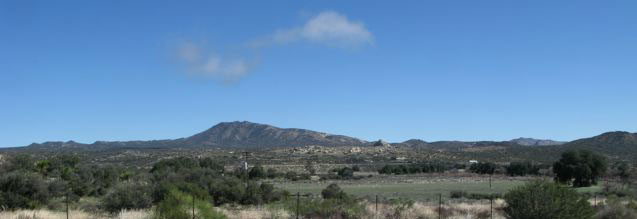
January 4, 2011 - A large wind project in eastern San Diego County, California, on the edge of the Colorado Desert, will impact rural backcountry scenery and potentially harm wildlife. The placement of numerous tall wind turbines will be a violation of the Bald and Golden Eagle Protection Act. The Fish and Wildlife Service has found a golden eagle nest within 1,000 feet of the project site. They also say "Take is likely."
The Tule Wind, ECO Substation, Energia Sierra Juarez wind Draft Environmental Impact Report/Environmental Impact Statement found that under the California Environmental Quality Act the NO Project is the Environmentally Superior Alternative but that when NO Project is the top alternative, CEQA also requires the selection of another Environmentally Superior Alternative. That choice is a reduced project with the removal of almost half of the turbines: 17 from tribal land, 27 from Bureau of Land Management, 7 from State land, and 11 from private land. This reduced project is also the BLM's Preferred Alternative and was the reportedly the result of an agreement between FWS and BLM on mitigation for Golden Eagles.
There a massive significant cumulative impacts to the area on Golden Eagles, Bighorn Sheep and other wildlife from the Sunrise Powerlink, Ocotillo Express Wind project, Energia Sierra Juarez wind project, and many other projects. See the cumulative impacts map at page 7 of this link: http://www.cpuc.ca.gov/environment/info/dudek/ecosub/Draft_EIR/F_Cumulative.pdf
See the reduced project map:
Figure E-1 Environmentally Superior Alternative on page 35 of the linked pdf.
http://www.cpuc.ca.gov/environment/info/dudek/ecosub/Draft_EIR/E_ComparisonofAlternatives.pdf
[Federal Register: January 4, 2011 (Volume 76, Number 2)]
[Page 381-382]
DEPARTMENT OF THE INTERIOR
Bureau of Land Management
[CACA 49698, CACA 51204, LLCAD07000, L51010000.FX0000, LVRWB10B3810,
LVRWB10B3800]
Notice of Availability of the Draft Environmental Impact Statement/Draft Environmental Impact Report for the Iberdrola Renewable/Pacific Wind Development Tule Wind Project and San Diego Gas and Electric's East County Substation Project, San Diego County, CA
ACTION: Notice of Availability.
-----------------------------------------------------------------------
SUMMARY: In accordance with the National Environmental Policy Act of 1969, as amended (NEPA), and the Federal Land Policy and Management Act of 1976, as amended (FLPMA), the Bureau of Land Management (BLM) and the California Public Utilities Commission (CPUC) have prepared a Draft Environmental Impact Statement (EIS), and Draft Environmental Impact Report (EIR) as a joint environmental analysis document for the
Iberdrola Renewable/Pacific Wind Development Tule Wind Project (Tule Project) and the San Diego Gas and Electric's (SDG&E) East County Substation Project (ECO Project) and by this notice are announcing the opening of the comment period on the Draft EIS/EIR.
DATES: To ensure that your comments will be considered, the BLM must receive written comments on the Draft EIS/EIR by close of business on February 16, 2011. The comment period began on December 23, 2010, with publication of the Notice of Availability in the Federal Register by the Environmental Protection Agency. Recognizing that the public review period began during the holidays, the BLM has decided to extend the 45-
day comment period cited in the EPA notice until close of business on February 16, 2011 (55 days total). The BLM and CPUC will hold two joint public informational workshop meetings on the projects; the first in Jacumba, at 7 p.m., on January 26, 2011, at the Jacumba Highland Center on 44681 Old Highway 80, Jacumba, California 91934, and the second in Boulevard, at 7 p.m., on February 2, 2011, at the Boulevard Volunteer
Fire Department at 39223 Highway 94, Boulevard, California 91905. The public will be notified in advance of any updates or changes to these public meetings through local media, newspapers and the BLM Web site at: http://www.blm.gov/ca/st/en/fo/elcentro.html.
ADDRESSES: You may submit comments related to the Tule Wind Project and East County Substation Project by any of the following methods:
Web site: http://www.blm.gov/ca/st/en/fo/cdd.html.
E-mail: catulewind@blm.gov.
Fax: (951) 697-5299.
Mail: ATTN: Greg Thomsen, BLM California Desert District Office (CDDO), 22835 Calle San Juan de Los Lagos, Moreno Valley, California 92553-9046.
Copies of the EIS/EIR are available on the BLM Web site at: http://www.ca.blm.gov/elcentro and also from the CPUC and the CDDO at the above addresses and in the BLM El Centro Field Office, 1661 S. 4th Street, El Centro, California 92243.
FOR FURTHER INFORMATION CONTACT: For further information and/or to have your name added to our mailing list, contact Greg Thomsen, telephone: (951) 697-5237; address: BLM California Desert District Office, 22835 Calle San Juan de Los Lagos, Moreno Valley, California 92553-9046; or via e-mail to catulewind@blm.gov
SUPPLEMENTARY INFORMATION: The BLM has received applications for rights-of-way (ROW) for two separate, but related, proposed projects in eastern San Diego County. Pacific Wind Development (Iberdrola) has submitted an application to construct, operate, maintain and decommission a 200 megawatt (MW) wind energy generation facility known
as the Tule Wind Project. The proposed project site is located on approximately 15,390 acres of land under multiple jurisdictions summarized as follows: Private land--1,040 acres, California State Lands Commission land--619 acres, BLM land--12,133 acres and Tribal land belonging to the Campo/Cuyapaipe/Manzanita Tribes--1,598 acres.
The project site is located in the In-Ko-Pah Mountains near the McCain Valley in San Diego County, north of the unincorporated community of Boulevard. The project will consist of approximately 134 wind turbines (1.5 to 3.0 MW each), an overhead and underground 34.5 kilovolt (kV) collector system leading to a collector substation, an operations and
maintenance facility, and a 138 kV transmission line as the generation tie-in to the existing Boulevard Substation. The SDG&E has submitted an application to construct the ECO
Project, including a 138 kV transmission line that would traverse approximately 1.5 miles of public land managed by the BLM. The ECO Project includes the construction of a 500/230/138 kV substation on private land near the community of Jacumba, a short loop-in to the Southwest Power Link, the 138 kV transmission line mentioned above, a
rebuild of the existing Boulevard Substation, and a rebuild of the existing White Star Communication Facility.
The BLM's purpose and need for the Tule and ECO Projects is to respond to Iberdrola Renewable/Pacific Wind Development and SDG&E applications for a ROW grant to construct, operate, and decommission an energy generation project and a 138 kV transmission line on public lands in compliance with Title V of FLPMA (43 U.S.C. 1761), BLM ROW regulations, and other applicable Federal laws and regulations. The BLM will decide whether to approve, approve with modification, or deny issuance of a ROW grant to Iberdrola Renewable/Pacific Wind Development and SDG&E for the proposed Tule and ECO Projects, respectively. The BLM will take into consideration the provisions of the Energy Policy Act of 2005 and Secretarial Orders 3283 Enhancing Renewable Energy Development on the Public Lands and 3285 Renewable Energy Development by the
Department of the Interior in responding to the Iberdrola and SDG&E applications.
The BLM's proposed action in the EIS/EIR is to authorize the Tule Project and the ECO Project in response to the applications received from Iberdrola Renewable/Pacific Wind Development and SDG&E, respectively. The BLM will analyze the following alternatives: for the ECO project; the Proposed Action and No Action alternatives; for the Tule Wind Project; the Proposed Action, authorization of the proposed project with a relocation of the 138 kV generation tie-in line, authorization of the proposed project with a reduction in the number of wind turbines, authorization of the 113 wind turbines, but moving them
away from critical habitat and areas having wilderness characteristics, and a No Action alternative.
The BLM will use the NEPA process to satisfy the public involvement requirement for Section 106 of the National Historic Preservation Act (16 U.S.C. 470f) as provided in 36 CFR 800.2(d)(3). Native American Tribal consultations are being conducted in accordance with BLM and Department of the Interior policy, and Tribal concerns will be given
due consideration, including impacts on Indian trust assets. The BLM has entered into a Memorandum of Understanding (MOU) with the CPUC to conduct a joint environmental review of the Tule/ECO Projects on Federal land managed by the BLM. The CPUC is the CEQA lead agency preparing the EIR and the BLM is the lead agency preparing the
EIS. The BLM and CPUC have agreed through the MOU to conduct joint environmental review of the project in a single combined NEPA/CEQA process and document. The Draft EIS/EIR evaluates the potential impacts of the proposed Tule and ECO Projects' impacts on air quality, biological resources, cultural resources, water resources, geological
resources and hazards, land use, noise, paleontological resources, public health, socioeconomics, soils, traffic and transportation, visual resources, wilderness characteristics, and other resources. A Notice of Intent to Prepare an EIS/EIR for the Tule and ECO Projects in San Diego County, California was published in the Federal Register on
December 29, 2009 (74 FR 68860). The BLM held two public scoping meetings in Jacumba and Boulevard, California, on January 27 and 28, 2010, respectively. The formal scoping period ended on February 15, 2010. Please note that public comments will be available for public review and disclosure at the above address during regular business hours (8 a.m. to 4 p.m.), Monday through Friday, except holidays. Before including your address, phone number, e-mail address, or other personal identifying information in your comment, you should be aware that your entire comment--including your personal identifying
information--may be made publicly available at any time. While you can ask us in your comment to withhold your personal identifying information from public review, we cannot guarantee that we will be able to do so.
Grant Program Passes
December 17, 2010 - The House passed the $858 billion tax package late last night which included an extension of the US Treasury Grant Program that gives tax-payer money to solar companies to cover the cost of 30% of construction for solar power plants. Solar, wind, geothermal, and ethanol business groups lobbied hard to get the subsidies, giving nearly $1.3 million to 71 senators and 229 House members.
Hundreds of millions of dollars of subsidies are involved for 2011, as BrightSource's Ivanpah Solar Electric Generating System project alone is estimated to cost $2 billion to construct. They will receive 30% of this as a grant (not loan) after completetion.
Companies like Solar Millennium were hoping to get the grant program extended, because the deadline to qualify for it was December 31, 2010. A project had to show 5% construction begun before this date to get the grant. Now solar projects that are behind can still qualify for the grant in 2011. Companies like Tessera told the California Energy Commission during hearings that the grant was absolutely necessary to be able to build, as capital costs for solar thermal projects are high.
http://www.greentechmedia.com/articles/read/senate-passes-extension-of-1603-tax-grant-program/
Transmission Costs Huge for Remote Renewable Energy Projects
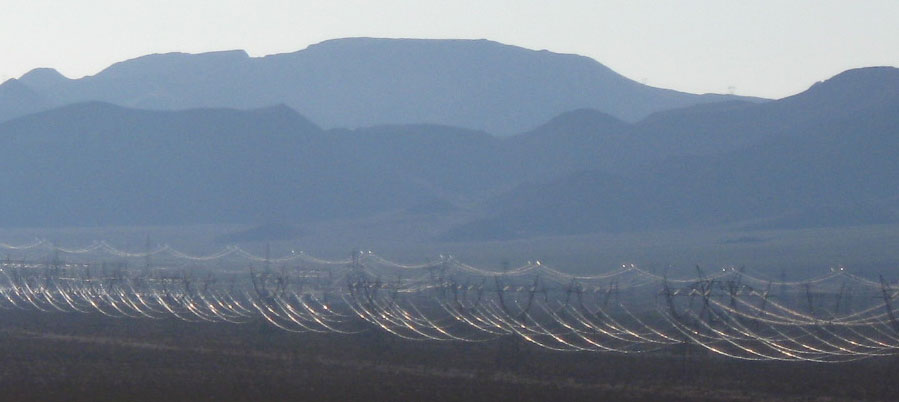
September 13, 2010 - Work has begun on the $3.5 billion Tehachapi transmission project, the largest in Southern California Edison history. The line will carry 4,500 megawatts from the Tehachapi Mountains in Kern County, California, to the Los Angeles basin. Wind energy will contribute.
http://losangeles.cbslocal.com/2010/09/07/work-begins-on-desert-power-transmission-towers/
The length is 173 miles:
This brings the price of new transmission into the $20 million + per mile range.
Governor Arnold Schwarzenegger said, "This year alone, there are two dozen renewable energy projects looking to break ground that will create thousands of jobs and billions of dollars of investment in our state. Many of these projects will be built in remote locations so we need transmission lines, just like the Tehachapi Renewable Transmission Project, to bring the clean electricity to the cities where people live and work."
This project is part of $5.5 billion that SCE is expected to spend on the transmission grid over the next 5 years. The full price tag of laying transmission lines for renewable energy is estimated at $15.7 billion by California legislators.
Abengoa Mojave Solar Project Licensed
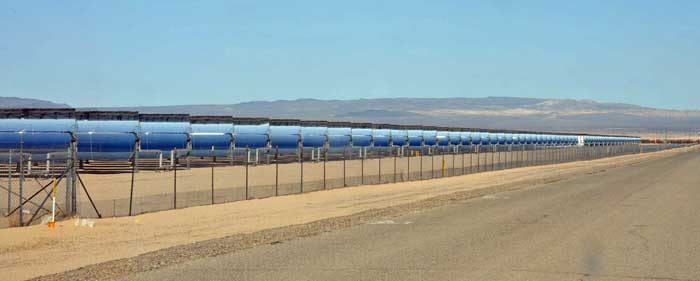
^SEGS plant owned by NextEra Enertgy, currently at Harper Lake. Abengoa Mojave Solar Project will dwarf this plant.
September 8, 2010 - Harper Lake Basin, San Bernardino County, California. The California Energy Commission approved the second largescale solar project, after Beacon Solar Energy Project.
In a unanimous vote, the Energy Commission adopted the presiding member's proposed decision (PMPD) that recommended licensing the 250-megawatt (MW) facility planned for northwest of Barstow. The Abengoa Mojave Solar Project is being proposed by Mojave Solar LLC, a subsidiary of Abengoa Solar Inc. The proposed project would use parabolic
trough technology where parabolic mirrors are used to heat a transfer fluid which is then used to generate steam.
The proposed facility will be constructed on 1,765 acres of private land that had been used for agricultural purposes. Harper Basin is in critical overdraft, and the impacts of further groundwater pumping will have to be watched. Presently SEGS VIII and SEGS IX, each 80 MW, built in 1989 and 1990, run using wet-cooling technology next to a small wetland.
Beacon Gets License
August 25, 2010 - California Energy Commission Licenses First Solar Thermal
Power Plant in 20 Years.
SACRAMENTO - The California Energy Commission today approved the construction of the proposed Beacon Solar Energy Project, the first solar thermal power project permitted in 20 years.
"Today's action begins the journey of increasing clean renewable energy in California," said Energy Commission Chairman Karen Douglas.
Douglas served as the presiding member of the committee that reviewed the plant's application for certification.
In a unanimous vote, the Energy Commission adopted the presiding member's proposed decision (PMPD) that recommended licensing the 250-megawatt facility in eastern Kern County.
The last solar thermal power plants that the Energy Commission approved were Luz Solar Electric Generating Systems (SEGS) IX and Luz SEGS X in February 1990.
The PMPD for the Beacon Solar Energy Project said the facility, as mitigated, will have no significant impacts on the environment and complies with applicable laws, ordinances, regulations, and standards. The PMPD was based solely on the record of facts that were established during the facility's certification proceeding.
Beacon Solar, LLC, a subsidiary of NextEra Energy Resources, LLC, would construct, own, and operate the proposed plant. The project is a concentrated solar electric generating facility on approximately 2,012-acres in eastern Kern County on the western edge of the Mojave Desert, four miles from California City and 15 miles north of the town of Mojave.
The project will use well-established parabolic trough solar thermal technology to produce electrical power using a steam turbine generator fed from a solar steam generator. The solar steam generators receive heated heat transfer fluid from solar thermal equipment comprised of arrays of parabolic mirrors that collect energy from the sun.
The federal government and the State of California have established the need for the nation and state to increase the development and use ofrenewable energy in order to enhance the nation's energy independence,meet environmental goals, and create new economic growth opportunities.
For more information on the Beacon Solar Energy Project:
http://www.energy.ca.gov/sitingcases/beacon/
Hyundai Solar Plan
August 11, 2010 - Hyundai Heavy Industries said it has signed a $700 million deal with U.S.-based Matinee Energy on Monday to build the world's largest solar energy power plant.
The plant, which will be located in Arizona, is seen as a breakthrough in Korea's ambitions to become a leading global supplier of green energy technology. Hyundai Heavy Industries, the nation's largest shipbuilder, claims it is the only company in Korea to produce a complete line of solar power equipment, including polycrystalline silicon, solar batteries, modules and solar power systems.
Hyundai will build two facilities: a 150-megawatt solar energy power plant in Dragoon, Arizona, and a smaller 25-megawatt unit in nearby Cochise, both of which are located in the southeastern part of the state. Hyundai will be responsible for the engineering, procurement and construction of the plants. The solar energy module, a core part of the plant, will be produced at Hyundai's facility in Eumseong, North Chungcheong.
The deal will establish Hyundai as an international supplier of large-scale solar energy power plants, said Kim Kweon-tae. "We will do our best to win additional orders of large plants in the United States, as well as in Europe and Asia."
The project represents the first phase of a 900-megawatt solar energy project that will be located at 15 sites in California and Arizona, for which Hyundai Heavy Industries had been in negotiations since March. Hyundai won the order against competitors in Germany and China, which are leaders in the global solar energy industry. Hyundai is expected to get follow-on orders from Matinee Energy for the project.
Meanwhile, Hyundai Heavy Industries also announced yesterday that it acquired management control of Hyundai Oilbank from the Abu Dhabi-based International Petroleum Investment Co. after a prolonged court battle. The dispute had centered on whether Hyundai had first rights to buy back a 70 percent stake in Oilbank that was being sold by IPIC. IPIC agreed to sell the shares to Hyundai after the International Chamber of Commerce recently ruled in favor of the Korean company.
Sent to us by a friend from JoongAng Daily news.
DRECP New Website
August 9, 2010 - The Desert Renewable Energy Conservation Plan is a cooperative agency plan to site renewable energy projects in a way that is responsible to conservation concerns, sensitive biological resources, and ecological processes. Unfortunately it is coming too late, as large projects are being sited in an irresonsible way, damaging fragile desert resources. We will be reviewing the latest August Draft Plan, which has good recommendations, but in the meantime here is the new website: http://www.drecp.org/
On November 17, 2008, Governor Arnold Schwarzenegger signed Executive Order # S-14-08 that sets California's goal of 33 percent of electricity coming from renewable resources by 2020 and improves processes for licensing renewable projects. In addition, the Governor ordered the development of the Desert Renewable Energy Conservation Plan (DRECP) for the Mojave and Colorado deserts that would, when complete, provide binding, long-term endangered species permit assurances and facilitate renewable energy project review and approval processes.
To oversee the implementation of the DRECP, a Renewable Energy Action Team (REAT) was formed consisting of the California Natural Resources Agency, California Energy Commission, California Department of Fish and Game, Bureau of Land Management, and the U.S. Fish and Wildlife Service. Memoranda of Understanding (MOUs) were signed by the participating agencies. Others joining the team include the California Public Utilities Commission, California Independent System Operator, National Parks Service, and the Department of Defense.
Four major products are being developed under the Renewable Energy Executive Order and the REAT:
Best Management Practices and Guidance Manual: Desert Renewable Energy Projects. (The Revised Staff Draft (PDF file, 2.4 MB) version is currently available.)
Draft Conservation Strategy that clearly identifies and maps areas for renewable energy project development and areas intended for long-term natural resource conservation as a foundation for the DRECP.
Desert Renewable Energy Conservation Plan -- a joint state and federal Natural Communities Conservation Plan (NCCP) and part of one or more Habitat Conservation Plans (HCP).
DRECP Draft and Final joint state and federal Environmental Impact Report/Environmental Impact Statement.
Molycorp Mine Revamp for Rare Earth Minerals
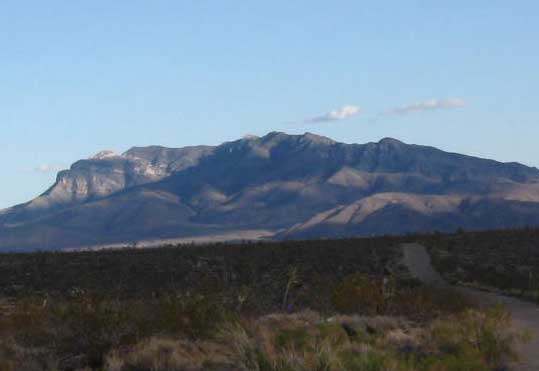
^Clark Mountain in Mojave National Preserve.
July 26, 2010 - Mountain Pass, California -- Renewable energy technologies require certain rare earth minerls, and the private 2,200-acre mine on the south side of Clark Mountain and the Mojave National Preserve, may become reactivated in the U.S. push for energy independence and national security.
The Mountain Pass mine, once the world's leading producer of rare earth minerals used to manufacture cutting-edge weapons and clean energy technologies, closed operations in 2002 after Chinese producers undercut its prices and a series of environmental spills stalled the renewal of state mining permits.
Today, the mine musters a fraction of its historical output and must ship the materials to Asia, where plants equipped with the technology to process the oxides into metals have created a virtual monopoly on the rare earth supply chain.
Molycorp Minerals in April registered with the Securities and Exchange Commission for an initial public offering to help raise the nearly $500 million needed to reopen and expand the mine. As part of reopening the mine, Molycorp plans to increase its capacity to mine and refine neodymium for rare earth magnets, which are extremely lightweight and are used in many high-tech applications. It will also resume bulk production of lower-value rare earth elements like cerium, used in industrial processes like polishing glass and water filtration. A Government Accountability Office report concluded that American military hardware, including Army tank navigation systems and Navy radars, rely on rare earth elements from China. Wind turbines and hybrid electric cars also need certain rare earths.
Molycorp hopes to improve safety and environmental protection at the Mountain Pass mine while using new technologies to drive operating costs below the level of Chinese mines. The Mountain Pass mine plans to recycle more of the costly acid used in ore processing, use a separate recycling system to reduce the need for fresh water to 30 gallons a minute from 850 and install a natural gas power plant to reduce its need to buy costlier and less reliable electricity from distant cities.
From Land Letter; New York Times.
Beacon Solar Energy Project Recommended by Commissioners
July 20, 2010 -
The California Energy Commission approval recommendation came out today for this large-scale solar energy project near California City, Kern County, California, specifically the Presiding Members Proposed Decision (PMPD). The two Commissioners that heard the case make their recommendation of Yes or No, which is then taken to the other 3 Commissioners, who then vote on it (always following the PMPD recommendation apparently).
(http://www.energy.ca.gov/2010publications/CEC-800-2010-005/CEC-800-2010-005-PMPD.PDF)
Beacon Solar Energy Project is on degraded agricultural land, but is getting away with wet-cooling, which takes a huge amount of water.
"It is estimated that the project would use approximately 1,400-acre feet per year (afy) of recycled water and 153 acre feet per year of groundwater with another 47 acre feet per year held for emergency reserve." The 1400-afy will come from either a California City new wastewater treatment plant to be built in 5 years, or a Rosamond wastewater treatment plant upgrade in 2-3 years, delivered by long pipelines. The 152 afy will come from 7 wells.
But, during construction the plant will need more than 8,000 acre-ft per year over two years, that is 5 to 10 million gallons of water per day. And this will have to be groundwater until the new wastewater treatment facilities are built.
We have visited this area many times and all the mesquite have died, the basin is overdrawn, the alfalfa farms are dead or dying, California City is having water problems.
From the PMPD: "During construction, the record indicates that water usage will be between 5 million and 10 million gallons per day (gpd), five days per week for a total period of 22 days per month for five months (or 110 days). Approximately 7,000 to 14,000 gallons per minute (gpm) of water will be required daily from seven wells to support initial construction activities. Following the initial five-month grading period, water will be used primarily for dust suppression and used in the construction of the solar field, power block and other site buildings and hydrostatic testing of the facility’s pressure vessels and piping. Site construction water use is expected to consume between 10,000 and 400,000 gpd for the remaining 22 months. During construction, total groundwater use is limited to 8,086 AFY. Potable water use would be limited to drinking water provided in bottles. Waterless portable facilities would be used for sanitary needs.
"The Applicant estimates that 1,388 AF of water will be consumed annually for power plant operation and potable water needs.
"The record shows that the volume of groundwater used for construction of the BSEP could equal 8,086 AF over a 25-month period. After construction, the use of groundwater drops dramatically to 153 AFY and stays at that level for the life of the project.
"It is estimated that the project would use approximately 1,400-acre feet per year of recycled water and 153 acre feet per year of groundwater with another 47 acre feet per year held for emergency reserve. According to pumping test data provided in the AFC, groundwater supply wells on the plant site have sufficient capacity (at least 2,000 gallons per minute) to meet the project’s water supply requirements.
"The site for the BSEP is a 2,012-acre project site located in eastern Kern County at the western edge of the Mojave Desert, just east of the southern end of the Sierra Nevada mountain range. The site is located approximately 4 miles northwest of California City’s northern boundary, approximately 15 miles north of the town of Mojave, and approximately 24 miles northeast of the City of Tehachapi. Koehn Lake is located approximately five miles to the east-northeast, and Red Rock Canyon State Park is located approximately four miles to the north.
"Development and construction is expected to cost approximately $950 million.
"The project site arrangement generally consists of a 1,266-acre, rectangular arrangement of parabolic trough solar collectors surrounding a centrally located power block. The power block facility houses the majority of electrical generation equipment and related systems, with exception of the solar field. The solar collectors will be constructed in long rows (troughs) across the project site and aligned side by side in a north-south orientation to allow the troughs to slowly rotate from east to west, tracking the movement of the sun. Adjoining the solar field, immediately to the west, are various support facilities, including administration and storage buildings, and evaporation ponds. The site also includes Pine Tree Creek, which currently bisects the site. Pine Tree Creek is a dry desert wash that the Applicant proposes to reroute to the southern and eastern boundaries of the project site. Together, the solar field, support facilities, transmission lines, and the drainage feature consume the majority of the 2,012- acre project site.
"The BSEP will consume approximately 1,400-acre feet per year of recycled water and 153 acre feet per year of groundwater with another 47 acre feet per year held for emergency reserve. There are 12 existing water supply wells that were previously used to support alfalfa farming on the project site. The Applicant proposes that three of these wells (Nos. 41, 49, and 63) be used to supply the project’s non-cooling water needs. The wells draw water from a lower aquifer at a depth of approximately 600 feet below ground surface.
Tertiary treated recycled water for cooling will be conveyed by underground pipe from wastewater treatment facilities located either in Rosamond or California City. In order to accommodate BSEP’s recycled water demands, both Rosamond Community Service District and California City would be required to expand their wastewater treatment facilities within their existing boundaries. In California City, this would include new sewer mains and connections to be located within the city, installation of an approximately twelve mile long recycled water pipeline from the wastewater treatment facilities to the Project, and the upgrade of the head works, aerator, clarifier, tertiary filter and replacing the chlorination equipment with UV disinfection within the existing wastewater treatment facilities. Rosamond Community Service District will convert two million gallons a day from secondary to tertiary treatment. These upgrades will include retrofits to existing equipment, and a twenty acre extension of a waste water pond, all of which would occur within the existing wastewater treatment facility. The recycled water pipeline from Rosamond is approximately 40 miles and will occur almost entirely along already disturbed and/or developed roadsides with paved and unpaved shoulders.
"Additional water will be required for make-up to the solar thermal and steam turbine system, washing of solar reflectors and collectors, potable water needs, and fire protection. The water is expected to be treated on site using a package water treatment system. The treatment system will be comprised of equipment for filtering, softening, de-mineralizing, and sanitizing the raw water."
Reid and Heller Unveil Renewable Bill
July 14, 2010 - Congressman Dean Heller and Senate Majority Leader Harry Reid introduced legislation the Clean Energy, Community Investment, and Wildlife Conservation Act. This would change the system for solar and wind developers from a Right-of-Way process (ROW) to a competitive lease auction.
Solar and wind companies would have to bid for leases on land made available from the Bureau of Land Management at an annual auction. States and counties would each get 25% of the lease and royalty income over the life of the project. Another undisclosed amount would go toward funding the BLM’s renewable energy offices.
"This bill will ensure the legacy of renewable energy development in Nevada and across the west," Heller said. "While we encourage renewable energy development, we are also promoting responsible development, reinvestment in wildlife and habitat, and enhanced recreation opportunities. This measure will create jobs, provide a fair return to our state and counties, and allow Nevada to be at the forefront of renewable energy development."
Reid also introduced legislation that would provide loans for high-risk geothermal energy exploration. The Geothermal Exploration Act would help developers overcome the high up-front costs of geothermal exploratory drilling.
See the Las Vegas Sun.
Solar Demonstration Zone in Nevada Test Site Announced
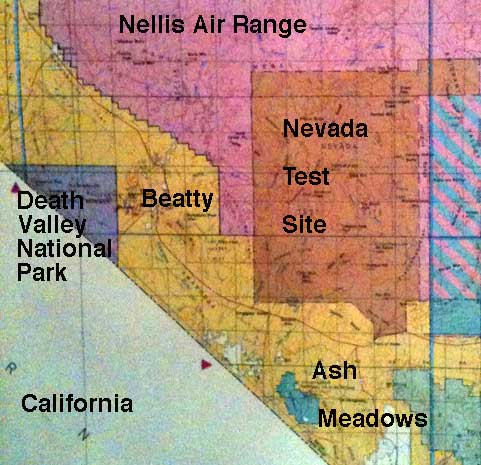
July 8, 2010 - Las Vegas, Nevada -
U.S. Department of Energy (DOE) Secretary Steven Chu, U.S. Department of Interior (DOI) Secretary Ken Salazar, and Senate Majority Leader Harry Reid of (D-Nevada) announced today the site of the new Solar Demonstration Zone to develop "cutting-edge solar energy technologies." The Solar Demonstration Zone will be located in the southwest corner of the Nevada Test Site, a former atomic bomb test site, on lands owned by the Department of Interior's Bureau of Land Management (BLM) and administered by DOE's National Nuclear Security Administration. Chu mentioned Stirling engines and solar thermal technology using hot oil (as a Heat Transfer Fluid) in his speech in Las Vegas.
"The Nevada Test Site is about to play a new role in securing America's future—but instead of testing nuclear weapons, we will test new solar technologies that will help put America on a sustainable energy path," said Secretary Chu. "Working closely with the Department of Interior, and with the critical leadership of Senator Reid, we will demonstrate technologies that will lower the cost of solar energy, accelerate the pace of innovation, and help build a clean energy economy."
"President Obama is committed to developing our nation's new energy frontier, including the promising area of advanced solar energy," Secretary Salazar said. "Our Bureau of Land Management, which oversees 23 million acres of Southwestern lands with solar potential, plays an important role in supporting the President's renewable energy goals. These projects on BLM land in Nevada can significantly reduce the costs and environmental impacts of utility-scale solar power facilities and demonstrate the commercial viability of these facilities. Thanks to Senator Reid's leadership, Nevada is ready to jump-start these projects, put people to work, and create more clean power."
"I am very pleased, but not surprised, that Nevada has been chosen as the site for this cutting-edge project," said Reid. "Nevada stands to be the leader in solar power production and technology development, especially with this kind of positive support from our federal partners. I am working on additional policies in the Senate to enhance Nevada's economy and create jobs through the production and export of clean renewable energy. The Nevada Test Site can and should be a proving ground for new ideas and for attracting new clean energy industries that will help our state and country compete globally."
Under the agreement, the federal government is dedicating more than 25 square miles to solar energy research—an area larger than Manhattan. DOE will use the site to demonstrate innovative Concentrating Solar Power (CSP) technologies. CSP systems concentrate the sun's energy and capture that energy as heat, which then drives an engine or turbine to produce electrical power. The Solar Demonstration Zone will complement BLM's establishment of 24 Solar Energy Study Areas (SESAs) on public lands across the U.S. Southwest by helping to ensure that the most advanced CSP technologies are ready for commercial deployment. Plans are underway to create a new DOE funding opportunity for demonstration projects at the Nevada Test Site that will include matching investments from the private sector.
DOE selected this site after reviewing 26 possible locations, evaluating factors including solar conditions, suitable terrain, and existing infrastructure to support solar projects. In addition to collaborating with each other, BLM and DOE are working in close coordination with the U.S. Air Force to identify and address potential problems with locating and operating the Solar Demonstration Zone at the Nevada Test Site. DOI and DOE will continue to collaborate with the Air Force and the Department of Defense. The site will serve as a test bed for other solar projects proposed near military installations throughout the desert southwest.
The Participants agree to work toward completion of the following milestones by the dates indicated:
Identify suitable demonstration area or areas: July 2010.
Initiate environmental review (under the National Environmental Protrection Act) for DOE demonstration activity within identified land area: July 2010.
Secure land control for demonstration area or areas: August 2010.
Begin design of demonstration projects. Make preliminary determinations concerning number, size, and technology for demonstration projects: September 2010.
Complete all necessary environmental reviews and analyses and, if necessary, issue appropriate decision document: June 2011.
Award land use authorizations to qualified demonstration projects: July 2011.
Begin site preparation and construction of shared infrastructure: July 2011.
Begin construction of demonstration projects: September 2011.
(From press release by US Department of Energy--Energy Efficiency and Renewable Energy)
We speculate the area, if in the southwest corner of the Test Site, would not be on land contaminated by radioactivity, but in the vicinity of Yucca Mountain. It might even be in the headwaters of Fortymile Wash which enters Amargosa Valley and flows southwards into the Solar Millennium Amargosa Farm Road CSP proposal. Wherever it is placed, water will be an issue for so large an industrial use.
HOME.....Renewable Energy News page 1....2....3....4....5....7
